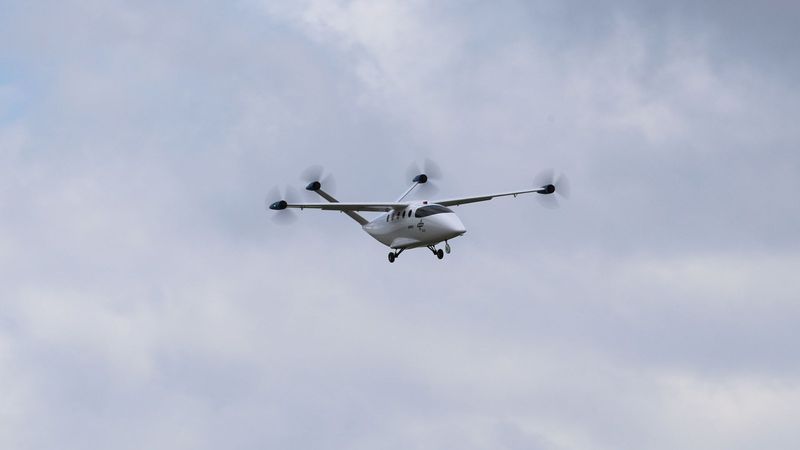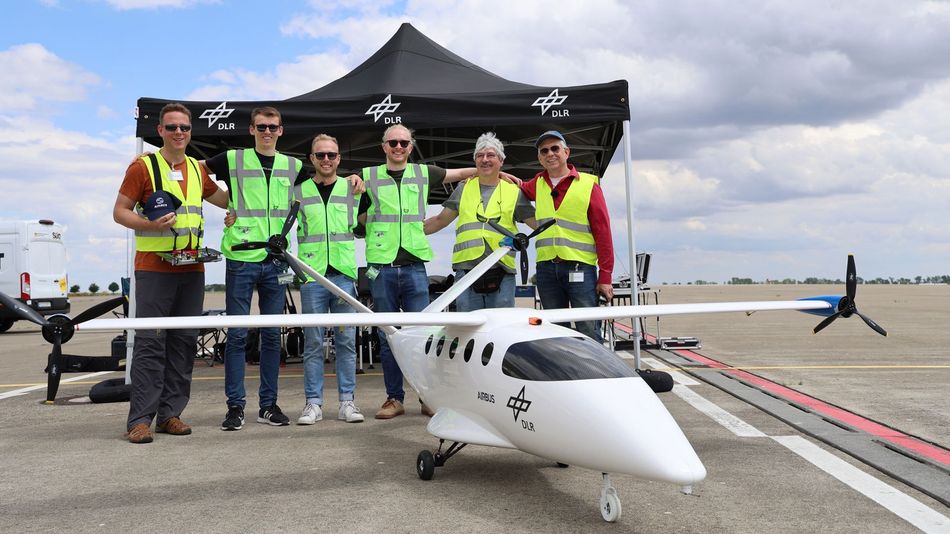DLR conducts first flight of HyBird demonstrator
HyBird is a small, hybrid-electric aircraft concept. Its goal is to serve routes of less than 1000 kilometres and with low passenger volumes in a climate-compatible way. The German Aerospace Center (DLR) has now successfully conducted the first flight of a 1:4 scale demonstrator of HyBird at the National Experimental Test Center for Unmanned Aircraft Systems in Cochstedt.

HyBird is currently a high-wing aircraft with a large propeller at each wingtip and at both tips of the V-tail. The initial concept has now evolved into a remotely piloted, instrumented experimental vehicle with a maximum weight of 25 kilograms. Credit: DLR (CC BY-NC-ND 3.0)
HyBird is a small, hybrid-electric aircraft concept. Its goal is to serve routes of less than 1000 kilometres and with low passenger volumes in a climate-compatible way. The German Aerospace Center (Deutsches Zentrum für Luft- und Raumfahrt; DLR) has now successfully conducted the first flight of a 1:4 scale demonstrator of HyBird at the National Experimental Test Center for Unmanned Aircraft Systems in Cochstedt. The concept, which combines two gas turbines, batteries and electrically powered propellers, was originally designed by students as part of the NASA/DLR Design Challenge 2019 and subsequently further developed by several DLR institutes and facilities in collaboration with Airbus ProtoSpace.
"Small aircraft carrying few passengers over comparatively short distances are ideal for bringing sustainable propulsion systems and concepts into widespread use as quickly as possible," says Markus Fischer, DLR Divisional Board Member for Aeronautics. "With HyBird, DLR is providing an innovative stimulus for climate-compatible connections to remote regions as well as for personalised short-haul air traffic from small airports. I am very pleased that this first demonstration flight has been successful. It will be followed by additional exciting flights and the continued development of this promising concept."
The flight tests in Cochstedt saw a new configuration flown for the first time. The current configuration of HyBird consists of a high-wing aircraft with a large propeller at each wingtip and at both tips of the V-tail. A hybrid propulsion system with two gas turbines for power generation and with the possibility to switch off one of the turbines in cruise flight significantly increases the energy efficiency compared to existing aircraft of this size. At cruising speed, in particular, it is possible to achieve a fuel consumption roughly as low as the per passenger, per kilometre energy requirement of a modern electric car. A 'battery boost' enables an all-electric take-off. The location and size of the propulsion systems also helps to reduce noise emissions.
HyBird is designed to carry five to nine passengers at least 700 to 1000 kilometres. The concept, submitted as part of the NASA/DLR Design Challenge by the winning team of students from the University of Stuttgart, has resulted in a remotely piloted, instrumented experimental vehicle with a maximum weight of 25 kilograms. "After winning the Design Challenge, things really 'took off'," recalls Project Lead Florian Will from the DLR Institute of System Architectures in Aeronautics. This success was followed by employment at DLR for the simultaneously scientifically in-depth and application-oriented research and implementation of the concept.
"With the first flight, we were able to collect a large amount of valuable data, which are now being used for the improvement of our concept," Will explains. "This is our strategy; with a demonstrator, you can conduct flight tests at a comparatively early stage. This allows us to gain extensive knowledge and expertise, which in turn flows directly into the design of future aircraft. We are planning another flight with the modified demonstrator before the end of this year."
FGAA - Future General Aviation Aircraft
The flight tests with the HyBird demonstrator are integrated into the DLR Future General Aviation Aircraft (FGAA) project. The aim of this project is to design a climate-compatible small aircraft that falls into the CS-23 certification category and to bring this into operation. It was within this context that the project team presented itself at the kick-off of the DLR_Startup Factory.
The FGAA early-stage researcher group is based at the DLR Innovation Center for Small Aircraft Technologies in Aachen. DLR researchers from the institutes of System Architectures in Aeronautics (Hamburg), Aerodynamics and Flow Technology (Göttingen) and Electrified Aircraft Engines (Cottbus) work together in the group. The HyBird demonstrator was constructed by Airbus ProtoSpace at the Center of Applied Aeronautical Research in Hamburg.

